September 21st, 2010 · No Comments
England’s religious identities are many. The influx of Muslims, Sikhs, and Hindus over the past century has turned the nation into a melting pot of both cultures and faiths. With the complexity of the social makeup of the city, it’s hard to pin down a “religious identity” for the whole of London. That being said, I think that one place of worship certainly has to be regarded as the national symbol for faith and strength- St. Paul’s Cathedral. While the religious denotations of the church are ever present, I don’t think the fact that it is a place of Christian worship is necessarily what gives it its majesty or its importance to Londoners across the metropolis. It is, above all, a symbol of a culture; strong and resilient, huge and complex, beautiful in its intricacies. There are two major times in London’s history during which the citizens of the city- Christian or not- have needed St. Paul’s.
Rebuilding after the Great Fire-
The Great Fire of 1666 ravaged the city whole. It gutted the mostly wood-lined streets and left a smoldering heap in its wake. The old St. Paul’s Cathedral (on whose ashes Wren’s St. Paul’s is built) was utterly destroyed. Wren sought to bring a new, majestic design to the table- he wanted a Renaissance-style dome to crown his masterwork and to be visible for miles around. While the design was initially scoffed at, his beautiful dome was completed and stood as the tallest structure in the city for three centuries. The cathedral is a symbol of Christianity, to be sure. But it is also, almost more importantly, a symbol of London’s rebirth from the depths of the catastrophe of 1666. The visible and towering symbol of Britain’s strength most certainly gave Londoners hope that their city was not only being restored, but taken to new heights.
The Blitz-
In terms of pure physical damage to the city, the only event that comes close to the devastation of the Great Fire is the Blitz. Nazi bombers annihilated much of the city in waves of attacks, night after night. Much of the history of the city was lost in the bombing raids, but the most important symbol of London’s strength miraculously remained. The iconic photograph of St. Paul’s, seemingly engulfed in flames but standing tall and true, is the embodiment of the church’s significance. Wren built the cathedral from the ashes of one fire with the intention that it would be a symbol of the strength of God and the strength of the city. The fact that the symbol itself resisted a second fire, an even greater test of resolve, is testament to its stature as the guiding light of London’s people. Christian or Muslim or Sikh, it’s impossible for Londoners not to stand in reverence (or, at least, in awe) of this building.

http://www.johndclare.net/wwii6b.htm
Tags: 2010 Patrick
September 19th, 2010 · No Comments
One of the things that has truly surprised me during our time in London and in our readings over the summer was the lack of a widespread religious sentiment and a growing secular way of thinking. Visiting the different places of worship for me has been very enriching. I sincerely enjoyed hearing about the way different roles of various institutions in their communities. Despite this growing secular sentiment, it was evident to me that faith is still an important key to Englishness. Sure, we may not have had the same treatment at the Christian institutions we visited, but we weren’t at the parish church where they would have stressed the other parts of Christianity outside of the famous dead people.
At the mandir, mosque, and synagogue, I did learn something about other faith communities, all of which I wasn’t that familiar with. Familiar with Christian outreach, it was interesting to hear the way other faiths volunteer and conduct outreach. I was also intrigued by the amount of history each guide mentioned; at the mandir, there was a specific exhibit to help you understand the history and beliefs of Hinduism. At the mosque, the guide spent more time on the basic principles, whereas at the synagogue it was much more history heavy, which I enjoyed (despite the slight mix up with who declared the crusades and who ordered Richard’s). Yet, they all stressed the importance of the community and what they did for the community. At the end of each tour, I felt that I had been where a faith was active and thriving- counteracting the general arguments we had encountered.
Before I talk about my favorite experience, I’m going to go off on a bit of rant/tangent. (Nothing unusual, you’re probably thinking.) While Christianity is undeniably not as much on the forefront as it once was (I sometimes forget I’m not in the Middle Ages where the church was as influential as those in political power and grotesques littered the cathedral for unknown reasons), it is still playing an important role in England. How? Most noticeably, the concerts we’ve attended. Sure, they haven’t been lectures in Christianity, but they have brought people into a church where they were witnessing a faith community. You don’t necessarily have to have a lecture about the religion’s history when you are there in order to spark an interest. Sometimes a few trips for concerts or to be a tourist will spark an interest and prompt someone to ask a question that leads to a serious discussion. Yes, it would have been nice to have left any of the churches/cathedrals with a pamphlet on basic Christianity, but because those audiences (presumably) weren’t there to learn about Christianity, a pamphlet may have been more alienating than encouraging.
Okay, so my favorite experience and what it taught me. Hands down, my favorite has been (no surprises) Westminster Abbey. (This may change as I’m hoping to get over to St. Bartholomew the Great tomorrow; it’s a medieval parish church.) Why when it didn’t actually teach me about Christianity or the abbey that I didn’t know? One, because it inspired my faith through the sweeping architecture and stained glass. For me, those are more impressive and awe-inspiring than St. Paul’s (in its present Wren-wrecked – okay, so maybe that’s a bit harsh-state) could ever dare to be. Two, because as a medievalist, I was able to participate in a long-standing tradition: the pilgrimage. Throughout history, people have visited sites throughout the world for many reasons. At Westminster Abbey, everything I love was combined into one place: my faith, grotesques, cosmati, saints, Chaucer, Gothic architecture, etc. I was on a pilgrimage of sorts. True I wasn’t there to pay my respects to Edward per se, but I can’t deny seeing the tomb of such an important figure didn’t give me chills (even though it’s been really messed up and reassembled incorrectly). I didn’t necessarily have to learn anything about Christianity to have an incredible experience. Yet, to say I didn’t learn anything is mistaken. I did, but I learned more about the position of the Church of England. It is clearly in decline, but the abbey is doing what it can given its monumental dual-purpose (protect priceless art and architecture while spreading its Christian message).
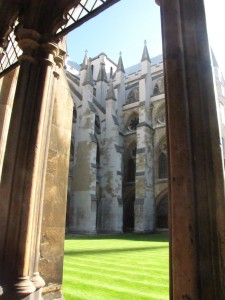
I’m sure some of us would argue that it is up to these major institutions to take the lead in revitalizing Anglicanism, and to some extent Christianity, in England. However, because Westminster Abbey stands for so much more than just Christianity (whether this is a good or bad thing is up for debate), it is important for some of the parish churches to be more vocal on these issues. For Westminster Abbey (and to some extent St. Paul’s) to take a major stand is a conflict of interests, a problem that lays at the heart of its problems rises: should it risk alienating the audience that helps it survive in order to promote its beliefs? It shouldn’t compromise its faith (and I don’t think it does; it does remain closed for services on Sundays as well as hosts small prayers and services throughout the day/week) in order to protect its architecture, nor should it compromise its architecture to protect its faith. They go hand-in-hand in many regards. Without either, you lose part of the abbey. If there was ever a lose-lose, impossible to win situation, double-edged sword, etc, this was it!
I’m hoping as I visit other major medieval cathedrals, a solution to the Christianity vs. tourism problem will become evident, but for now Westminster Abbey will have to be simply (as its Cloister represented for its medieval monks) my paradise on earth.
Tags: 2010 Stephenie · Churches and Cathedrals
August 26th, 2010 · 1 Comment
To get to St. Paul’s Station, we took the Tube from Goodge Street Station to the Tottenham Court Road Station, and then stayed on the central line for a few more stops until we arrived at St. Paul’s. It took us a little over ten minutes to get from the hotel to Saint Paul’s, including walking down 169 steps after we decided to skip the escalator. The Tube was very easy to navigate, although the map certainly came in handy. Holly, whose town has absolutely no public transportation, was impressed by how orderly everything was—people paid strict adherence to instructions to “mind the gap” and to keep right if they weren’t moving on the escalator, so as to let those in more of a hurry pass by.

St. Paul’s proved to be a very popular station, probably because it offers access to many London landmarks and museums, including St. Paul’s Cathedral, for which it is named. It is also within walking distance of the Tate Modern and St. Bartholomew’s Hospital, as well as several office buildings. Walking around the area around the station, we realized that St. Paul’s is a gateway to the City proper. 
Just beyond the station lies St. Paul’s Cathedral surrounded by beautiful old buildings that resembled a postcard image of London. We decided that the cathedral itself was the best monument to highlight, as it is such an iconic part of the London skyline and is a standing monument to Sir Christopher Wren’s work. 
The area outside of the cathedral was teeming with tourists, most of whom did not display much religious inclination. There were a number of people milling around inside of the cathedral, but very few were actually there to pray or worship, and they were secluded at the front of the church.
There were also several groups of tourists outside of the church, and we were surprised at how informally they treated the area. One tour guide even jumped onto a statue of John Wesley and put his arm around the statue while he talked to the group. In general, people seemed to be more intent on taking pictures than on listening to the tour guide or reading the plaques (of which there were very many) that explained the significance of St. Paul’s. History was emphasized, however, with all of the plaques in the area. There were several statues on the cathedral grounds that commemorated religious figures, including St. Paul’s cross, which was supposedly erected first in 1191. On the other side of the station, we found Christ Church Greyfriars, another Wren creation, which was partially destroyed. The ruins of the knave have since been turned into a garden. This section seemed more business-y than the area immediately around St. Paul’s Cathedral, however.
On the walk back from Saint Paul’s Cathedral, we chose to walk down Newgate Street, which soon turns into High Holborn. Along this stretch, Baroque style architecture, characterized by ornate marble carvings and columns predominated. 
Soon enough, we walked upon the Holborn circus, a tiny traffic circle with a statue in the middle,. Finding the subject of the statue was made difficult by the traffic moving quickly around it, however, we later found the statue to be of Prince Albert. As we moved toward New Oxford Street, the architecture tended to be more of the modernist variety, with the odd Victorian building, and Georgian style architecture becoming more predominant in Bloomsbury.
Tags: 2010 Holly · 2010 Tyler
On Wednesday September 2nd, 2009 the Norwich Humanities group visited the East End, in particular, Brick Lane, and the surrounding area. Brick Lane’s history over the past 15 years had changed drastically. It has gone from a neighborhood of violence, drugs, and trash, to a respectable neighborhood. This area has seen drastic progress in this fifteen year period, but progress at the expense of who?
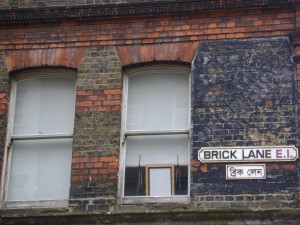 People always view progress as a positive thing, because, it means improvement for a community that means it. What I have learned being in London, is that progress has the potential to be something great, but at the expense of who? Professor Qualls has made me realize these past few days, is that the concept of progress is something beneficial, to a specific group, but at the expense of who? In order for true progress to be made a specific group must pay. Looking at the east end, it is obvious that the area is becoming economically improved, but at the expense of the middle and working classes in the area. The area is beginning to see major improvements, in both the markets and financial district, but the lower classes are taking a beating, because soon they will not be able to afford the area in which they live, and will be forced to move out. In essence this is progress in its truest form. However, it felt surreal to be in an area in which we have read so much about, and viewing the drastic changes in the area, gave me a sense of joy, but this emotion was balanced with a sense of sadness because of the effects this had on the community.
People always view progress as a positive thing, because, it means improvement for a community that means it. What I have learned being in London, is that progress has the potential to be something great, but at the expense of who? Professor Qualls has made me realize these past few days, is that the concept of progress is something beneficial, to a specific group, but at the expense of who? In order for true progress to be made a specific group must pay. Looking at the east end, it is obvious that the area is becoming economically improved, but at the expense of the middle and working classes in the area. The area is beginning to see major improvements, in both the markets and financial district, but the lower classes are taking a beating, because soon they will not be able to afford the area in which they live, and will be forced to move out. In essence this is progress in its truest form. However, it felt surreal to be in an area in which we have read so much about, and viewing the drastic changes in the area, gave me a sense of joy, but this emotion was balanced with a sense of sadness because of the effects this had on the community.
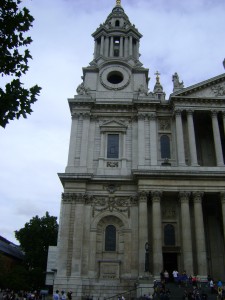 We later travelled to St. Pauls’ lead by our fabulous tour guide John. John was our tour guide for the West Minster Abbey, and because he did such an amazing job, professor Qualls decided John was more than capable to lead us in this national land mark of London. Once we all had arrived John began speaking about the birth of the St. Pauls’ Cathedral and the route and the history of its name. One thing Jon said before entering that I didn’t agree with was when he said, “be mindful that this place is still a church so please be mindful.” Once I entered St. Paul’s cathedral, I immediately noticed the outrageous fee to enter this “church.” I could not help but see this ever apparent contradiction, in that museum cost money, and churches are supposed to be free. Not only that but the electronic tour guides, and the amount of people who just seemed interested in looking at its architecture rather than praising god could have not convinced me more, that this Cathedral had lost its “holiness” a long time ago, at least in my opinion. My perceptions of St. Paul as a tourist attraction, however, were nothing but positive. The architecture was beautiful, and its history was astounding. As I climbed the steps of St. Pauls’ I could not help but think that in the immediate future I would be on the top of the city.
We later travelled to St. Pauls’ lead by our fabulous tour guide John. John was our tour guide for the West Minster Abbey, and because he did such an amazing job, professor Qualls decided John was more than capable to lead us in this national land mark of London. Once we all had arrived John began speaking about the birth of the St. Pauls’ Cathedral and the route and the history of its name. One thing Jon said before entering that I didn’t agree with was when he said, “be mindful that this place is still a church so please be mindful.” Once I entered St. Paul’s cathedral, I immediately noticed the outrageous fee to enter this “church.” I could not help but see this ever apparent contradiction, in that museum cost money, and churches are supposed to be free. Not only that but the electronic tour guides, and the amount of people who just seemed interested in looking at its architecture rather than praising god could have not convinced me more, that this Cathedral had lost its “holiness” a long time ago, at least in my opinion. My perceptions of St. Paul as a tourist attraction, however, were nothing but positive. The architecture was beautiful, and its history was astounding. As I climbed the steps of St. Pauls’ I could not help but think that in the immediate future I would be on the top of the city.
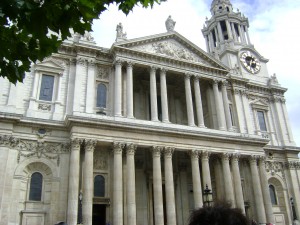 Once I arrived the scenery was amazingly beautiful, I had never seen such an astounding sight. I was able to view London from an entirely different vantage point, and in doing so, I realized the true beauty of this chaotic city. I realized that, London, was the only city I have ever been to that had such an interesting personality, from the people, to its appearance, its multifaceted diversity was something that out of a book. It was something I will not soon forget!!!
Once I arrived the scenery was amazingly beautiful, I had never seen such an astounding sight. I was able to view London from an entirely different vantage point, and in doing so, I realized the true beauty of this chaotic city. I realized that, London, was the only city I have ever been to that had such an interesting personality, from the people, to its appearance, its multifaceted diversity was something that out of a book. It was something I will not soon forget!!!
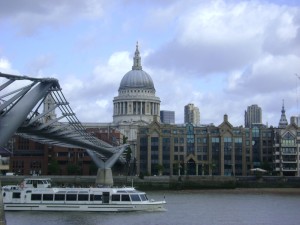
Tags: Anthony
September 4th, 2009 · 1 Comment

For a week and a half I’ve been telling people that St. Paul’s is my favorite building in London, even though I’d yet to go inside. I think it’s something about how it fits snugly in the city skyline, and yet at the same time seems totally foreign and unique. I prefer it to Big Ben as the quintessential symbol of downtown London and prefer it to Westminster Abbey as a church. Even if those photos of the dome standing tall during the blitz were doctored for propaganda purposes, they move me because even today I can get a sense of how inspiring they must have been to Londoners and indeed all Brits.
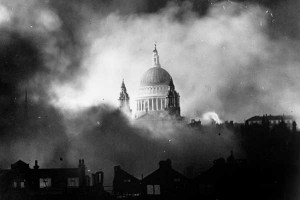
BBC image of St. Paul's in the blitz
That said, I was indeed impressed by the inside when I had a chance to see it. Although it’s certainly ornate, it seemed simpler and less cluttered than Westminster Abbey. The inherent awkwardness of St. Paul’s is that it has become the church most associated with elaborate monuments and graves to military men, and therefore is seen as glorifying war. I thought it was interesting that the hourly intercom prayer focused mostly on making the world a more peaceful place, seemingly to counteract the church’s obvious image. Anyone else notice that?
In retrospect I’d rather have climbed up to the dome (next time I will) but instead I chose to go down to the crypt to hear a little more from John. I really admire John’s ability to do what he does as well as he does it. The best I can describe what he does so well is point out the interesting minutiae while at the same time linking that back to an overall narrative which gives one an impression of what the particular place really means as a whole. Most tours, both audio and human, just don’t achieve this.
Staying for choral evensong was a good choice, although we should have sat up with the congregation rather than back with the tourists to really hear the choir sing. Nonetheless, the service was something to behold both visually and sonically. An organ and a great small choir in an amazing space is just about as good a musical experience as can be had, I think. The one problem I had with the experience was tourists just milling about the sides of the church during the service. During mass at Santa Maria Maggiore in Rome I saw this, too, and couldn’t believe people felt comfortable doing it. I understand why St. Paul’s (and the Abbey, for that matter) are and should be viewed as a museum to British history and religion, but I feel there should be times when it is a museum only and times when it is a place of worship only.
Not for reason of comparison, but just for the sake of convenience, I’d also like to add my thoughts on the guardwara (which we were lucky enough to not have to treat like a museum). I was glad to have a guide who was eager to talk to us about his faith but was not a rehearsed guide. This gave us a chance for a more candid exchange and probably a much more authentic experience. I noticed how, twice, other Sikhs just came up to hear what he had to say to us about Sikhism (and they just seemed interested, not wanting to correct him or know who we were).
One thing I should have mentioned this morning, during our brief discussion of St. Paul’s and the guardwara and Christianity and Sikhism, was that Sikhism is a religion that has a history of religious violence (despite its very pacifistic core). Some of you may have noticed a sign yesterday asking Sikhs to remember those who died in Operation Blue Star on its 25th anniversary. This was an operation ordered by Indian PM Indira Gandhi against Punjabi Sikh separatists who were amassing weapons in a temple. In the wake of Blue Star, Indira Gandhi was assassinated by her Sikh bodyguards. Sikhs, like members of other religions, struggle with when to take up the sword in defense of what they believe to be justice and honor and when to turn the other cheek, so to speak.
Tags: Aidan
Today’s walk to the East End was a new and different experience for me. Having grown up in a middle class, white, rural area it was wonderful to actually see the complete opposite of the area in which I grew up. As much as I love ethnic street fairs and pan-asian food I had never really seen an area so completely different from the one I am used to.
When I read Salaam, Brick Lane I had problems envisioning the actual street. As much as I enjoyed the book I still was picturing more of a slum than a habitable living area (Jack London’s quotes about murder and refuse didn’t help). Indeed, when the book was written things were much worse in that area than they are now, but it was still quite helpful for me to actually see the setting.
What struck me most was that even though the Gherkin could still be seen over the tops of the buildings, it actually felt like we were in a completely different city. Sadly most of the shops were closed due to Ramadan, but it is definitely a place I want to explore further.
However, it was surprising to see just how much it had changed since Mr. Hall wrote his book. From what he described I assumed Brick Lane to be little more than a slum. While not exactly the nicest neighborhood it was far from unpleasant. From the number of people in their mid-twenties that I saw wandering around it seems as though the area is an up-and-coming place. This is just another example of the ever changing demographic in this section of London. Instead of a new group of immigrants it seems to me that perhaps the next tenants will be young adults looking for their first apartment. From what I saw today I wouldn’t mind living there myself.
In contrast, this afternoon we took a tour of St. Paul’s Cathedral. It was quite a stark difference going from the rather poorer East End to the opulence of Christopher Wren’s masterpiece. While the entire tour was interesting, the highlight was definitely the trek up the dome. The view from the top was breathtaking. We were treated to a view of the whole of London spread out beneath us, and as segregated as parts of London are on the ground, from up that high there are no boundaries drawn between sections of the city. It is all just one big sprawling mass and there are no distinctions. It was a nice change from the racism we have been discussing during class.
It was a good day and I’d love to explore the East End further.
Tags: Campbell








 People always view progress as a positive thing, because, it means improvement for a community that means it. What I have learned being in London, is that progress has the potential to be something great, but at the expense of who? Professor Qualls has made me realize these past few days, is that the concept of progress is something beneficial, to a specific group, but at the expense of who? In order for true progress to be made a specific group must pay. Looking at the east end, it is obvious that the area is becoming economically improved, but at the expense of the middle and working classes in the area. The area is beginning to see major improvements, in both the markets and financial district, but the lower classes are taking a beating, because soon they will not be able to afford the area in which they live, and will be forced to move out. In essence this is progress in its truest form. However, it felt surreal to be in an area in which we have read so much about, and viewing the drastic changes in the area, gave me a sense of joy, but this emotion was balanced with a sense of sadness because of the effects this had on the community.
People always view progress as a positive thing, because, it means improvement for a community that means it. What I have learned being in London, is that progress has the potential to be something great, but at the expense of who? Professor Qualls has made me realize these past few days, is that the concept of progress is something beneficial, to a specific group, but at the expense of who? In order for true progress to be made a specific group must pay. Looking at the east end, it is obvious that the area is becoming economically improved, but at the expense of the middle and working classes in the area. The area is beginning to see major improvements, in both the markets and financial district, but the lower classes are taking a beating, because soon they will not be able to afford the area in which they live, and will be forced to move out. In essence this is progress in its truest form. However, it felt surreal to be in an area in which we have read so much about, and viewing the drastic changes in the area, gave me a sense of joy, but this emotion was balanced with a sense of sadness because of the effects this had on the community. We later travelled to St. Pauls’ lead by our fabulous tour guide John. John was our tour guide for the West Minster Abbey, and because he did such an amazing job, professor Qualls decided John was more than capable to lead us in this national land mark of London. Once we all had arrived John began speaking about the birth of the St. Pauls’ Cathedral and the route and the history of its name. One thing Jon said before entering that I didn’t agree with was when he said, “be mindful that this place is still a church so please be mindful.” Once I entered St. Paul’s cathedral, I immediately noticed the outrageous fee to enter this “church.” I could not help but see this ever apparent contradiction, in that museum cost money, and churches are supposed to be free. Not only that but the electronic tour guides, and the amount of people who just seemed interested in looking at its architecture rather than praising god could have not convinced me more, that this Cathedral had lost its “holiness” a long time ago, at least in my opinion. My perceptions of St. Paul as a tourist attraction, however, were nothing but positive. The architecture was beautiful, and its history was astounding. As I climbed the steps of St. Pauls’ I could not help but think that in the immediate future I would be on the top of the city.
We later travelled to St. Pauls’ lead by our fabulous tour guide John. John was our tour guide for the West Minster Abbey, and because he did such an amazing job, professor Qualls decided John was more than capable to lead us in this national land mark of London. Once we all had arrived John began speaking about the birth of the St. Pauls’ Cathedral and the route and the history of its name. One thing Jon said before entering that I didn’t agree with was when he said, “be mindful that this place is still a church so please be mindful.” Once I entered St. Paul’s cathedral, I immediately noticed the outrageous fee to enter this “church.” I could not help but see this ever apparent contradiction, in that museum cost money, and churches are supposed to be free. Not only that but the electronic tour guides, and the amount of people who just seemed interested in looking at its architecture rather than praising god could have not convinced me more, that this Cathedral had lost its “holiness” a long time ago, at least in my opinion. My perceptions of St. Paul as a tourist attraction, however, were nothing but positive. The architecture was beautiful, and its history was astounding. As I climbed the steps of St. Pauls’ I could not help but think that in the immediate future I would be on the top of the city. Once I arrived the scenery was amazingly beautiful, I had never seen such an astounding sight. I was able to view London from an entirely different vantage point, and in doing so, I realized the true beauty of this chaotic city. I realized that, London, was the only city I have ever been to that had such an interesting personality, from the people, to its appearance, its multifaceted diversity was something that out of a book. It was something I will not soon forget!!!
Once I arrived the scenery was amazingly beautiful, I had never seen such an astounding sight. I was able to view London from an entirely different vantage point, and in doing so, I realized the true beauty of this chaotic city. I realized that, London, was the only city I have ever been to that had such an interesting personality, from the people, to its appearance, its multifaceted diversity was something that out of a book. It was something I will not soon forget!!!

